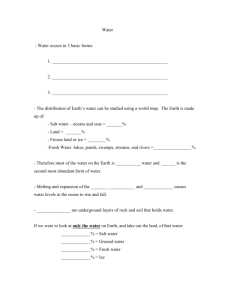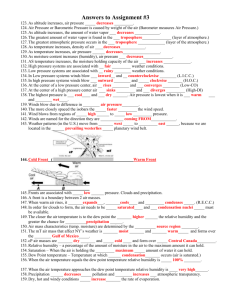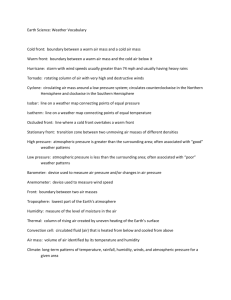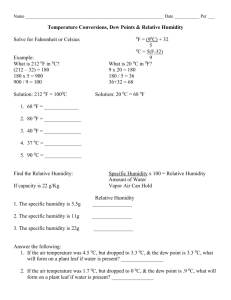Topic 7
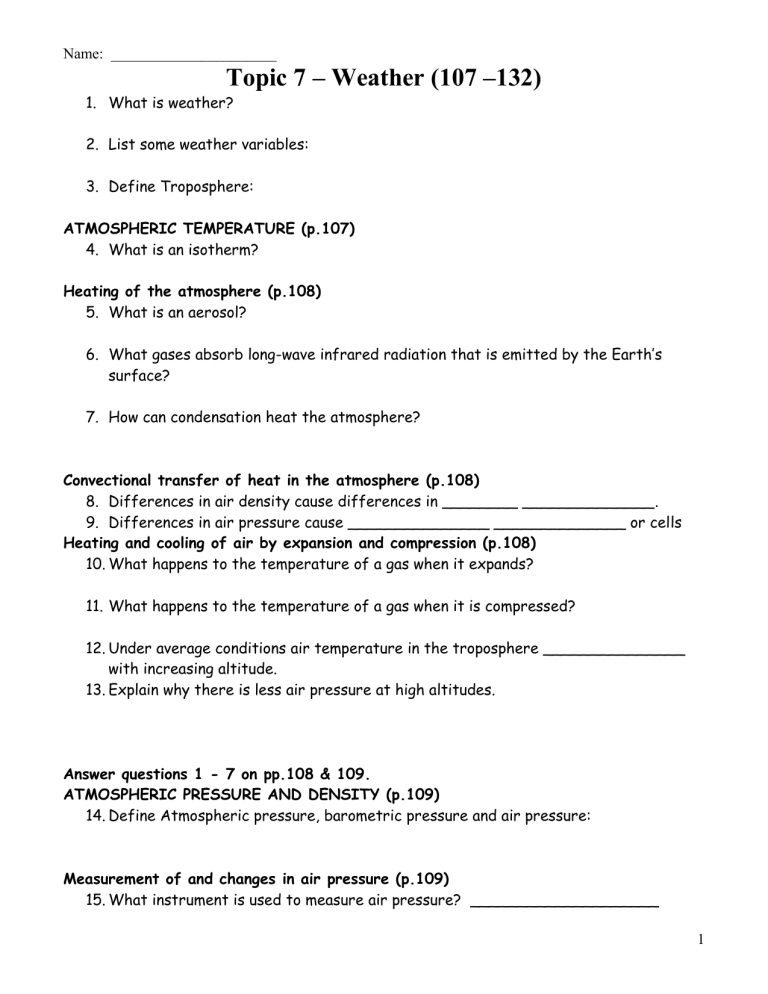
Name: ______________________
Topic 7 – Weather (107 –132)
1.
What is weather?
2.
List some weather variables:
3.
Define Troposphere:
ATMOSPHERIC TEMPERATURE (p.107)
4.
What is an isotherm?
Heating of the atmosphere (p.108)
5.
What is an aerosol?
6.
What gases absorb long-wave infrared radiation that is emitted by the Earth’s surface?
7.
How can condensation heat the atmosphere?
Convectional transfer of heat in the atmosphere (p.108)
8.
Differences in air density cause differences in ________ ______________.
9.
Differences in air pressure cause _______________ ______________ or cells
Heating and cooling of air by expansion and compression (p.108)
10.
What happens to the temperature of a gas when it expands?
11.
What happens to the temperature of a gas when it is compressed?
12.
Under average conditions air temperature in the troposphere _______________ with increasing altitude.
13.
Explain why there is less air pressure at high altitudes.
Answer questions 1 - 7 on pp.108 & 109.
ATMOSPHERIC PRESSURE AND DENSITY (p.109)
14.
Define Atmospheric pressure, barometric pressure and air pressure:
Measurement of and changes in air pressure (p.109)
15.
What instrument is used to measure air pressure? ____________________
1
Name: ______________________
Topic 7 – Weather (107 –132)
16.
What is an isobar?
Effect of temperature on air pressure (p.109)
17.
As the temperature of air increases, the air ______________ and its density and pressure ___________________ . Draw the line on the graph below to show this relationship
Effect of water vapor on air pressure (p.110)
18.
The greater the amount of water vapor in the air, the lower the air _____________ and _________________ . Since a water molecule weighs less than either a oxygen or nitrogen molecule, the greater the amount of water vapor in the air, the less dense the air becomes. Draw this relationship on the graph to the right.
Effect of altitude with air pressure (p.110)
Temp
19.
As altitude or elevation increases, atmospheric density and pressure
__________________ . As you go up higher, there is less gas above you. That means that the overall weight of the air above is less at the top of a mountain than at the base of a mountain. Draw this relationship on the graph to the right.
Answer questions 8 – 17 on pp.110 & 111
WIND (p.111)
Moisture
20.
Define wind:
Pressure
Wind speed (p.111)
21.
Winds are caused by ___________________________________________.
22.
Differences in air pressure are caused by ____________________________
23.
Define air pressure gradient:
24.
How can isobars be used to determine wind speed?
25.
What is the instrument that measures wind speed? _____________________
Study figure 7-3: The sea breeze and the land breeze.
Wind Direction (p.112)
26.
Air (wind) moves from areas of ______________ pressure to areas of
___________ pressure.
2
Name: ______________________
Topic 7 – Weather (107 –132)
27.
The Coriolis Effect deflects winds to the ____________ in the Northern
Hemisphere and to the ____________ in the Southern Hemisphere.
28.
Winds are named for where they __________________________.
29.
A south wind blows from the __________ to the ____________.
30.
A north wind blows from the __________ to the ____________.
31.
An east wind blow from the ___________ to the ____________.
Formation of Waves on Surface Water (p.112)
32.
How are ocean waves formed?
Answer questions 18 – 24 on pp.112 & 113.
GENERAL CIRCULATION OF THE AIR IN THE TROPOSPHERE (p.113)
Convection cells(p.113)
Figure 7-6 is very similar to the “Planetary Wind and Moisture Belts in the Troposphere” diagram on p.14 of the ESRT.
33.
What causes the convection of the atmosphere?
34.
Why is the air at the Equator on fig 7-6 rising?
35.
Why are the N.E winds and the S.E winds converging at the Equator?
36.
Why aren’t the paths of the winds straight lines?
37.
What is the jet stream?
38.
Where are the jet streams?
Planetary Wind and Pressure Belts (p.114)
39.
What does the word prevailing mean?
40.
What are prevailing winds?
Seasonal Shifting of the Wind and Pressure belts
41.
The High Pressure / Dry belt that is at 30ºN latitude on an equinox will move. In what direction will this High Pressure / Dry belt move in June? _____________
Where will it be in December? ________________ .
Weather movement in the Contiguous United States
42.
Most of the weather in the US moves from the ___________ to the ________.
Formation of Surface Ocean Currents (p.115)
43.
The general direction of surface ocean currents in the N. Hemisphere is
___________ . This is caused by the Coriolis effect.
44.
The general direction of surface ocean currents in the S. Hemisphere is …..
Answer questions 25 – 35 on p.116.
3
Name: ______________________
Topic 7 – Weather (107 –132)
ATMOSPHERIC MOISTURE (p.117)
45.
Define Evaporation:
46.
Define Transpiration:
47.
Define Evapotranspiration:
Energy of Evaporation and Transpiration of Water
48.
How much energy is required to change liquid water into vapor?
Process of Evaporation
49.
If the rate of evaporation (water molecules leaving the liquid state to become gas) is equal to the rate of water molecules returning back to the liquid state
(condensation) then the condition of ______________ _______________ exists.
Factors Affecting Evaporation Rates of Water
50.
Four factors control the rate of evaporation. List them: a.
b.
c.
d.
Humidity, Temperature and Dew Point (p.118)
51.
Define Absolute Humidity:
52.
The maximum absolute humidity is called ___________________________
53.
What is the relationship between temperature and water vapor capacity?
54.
Graph the relationship.
55.
Define Relative Humidity:
Temperature
56.
The closer the absolute humidity is to the maximum absolute humidity (moisture capacity), the __________________ the relative humidity.
4
Name: ______________________
Topic 7 – Weather (107 –132)
Relative Humidity and Temperature (p.118)
57.
If the temperature of the air changes but the amount of water vapor remains the same, the relative humidity will change. For example, if the temperature increases, the relative humidity will _________________ . This occurs because the capacity
____________ with the increase in temperature.
58.
If the temperature of the air remains constant, but more water vapor is added to the air by ______________ or _______________, both the absolute humidity and the relative humidity will ________________ .
Dew Point
59.
When the absolute humidity equals the moisture capacity, the relative humidity is
___________ %.
60.
The temperature at which this happens is called the ______________________.
61.
The dew point depends on _____________ humidity and not relative humidity. As the amount of water vapor in the air increases, the dew point _______________.
62.
What does saturated mean?
Measuring Relative Humidity (p.119)
63.
What instrument measures relative humidity? _________________________
64.
The dry-bulb thermometer measures the air temperature. The wet-bulb thermometer always measures equal to or less than the dry-bulb. Why is the wetbulb thermometer reading usually cooler than the dry-bulb?
Determining Dew Point – Exactly the same as relative humidity.
65.
Practice using p.12 of the ESRT to determine Relative Humidity and Dew Point
Temperatures.
Dry-Bulb
(ºC)
4
0
18
22
Wet-Bulb
(ºC)
-2
-2
15
17
Difference between Wet and Dry-bulb (ºC)
6
2
3
Relative
Humidity (%)
14
63
Dew Point
(ºC)
-19
13
Precipitation (p.120)
66.
Define Precipitation:
67.
List the various forms of precipitation:
Cloud Formation
68.
If the air temperature cools (often by expanding) below the ________
_________, the water vapor will usually _______________ to a liquid or sublimate to a solid, changing microscopic liquid water droplets to ice crystals.
5
Name: ______________________
Topic 7 – Weather (107 –132)
69.
What is a cloud?
70.
Besides needing saturated air, condensation usually requires a surface upon which the water vapor can condense. How come particles in the air such as dust, ash, and smoke are necessary for cloud formation?
What you really need to know about cloud formation is that air must rise, expand and cool to the dew point temperature. Once the air is cooled to the dew point temperature, the rate of
condensation is greater than the rate of evaporation and water vapor will condense into little tiny water droplets that will form a cloud.
Calculating Cloud Base Altitude (p.121)
71.
What happens to temperature and dew point as elevation increase?
Atmospheric Transparency and Precipitation
72.
What is the relationship between pollutants and transparency?
73.
How does precipitation help remove pollutants from the atmosphere?
Answer questions 36 -60 on pp.121 -123.
AIR MASSES AND FRONTS (p.123)
74.
An air mass is a large body of air that has similar characteristics of a.
b.
c.
Characteristics of Air Masses
75.
What is a source region?
Study figure 7 – 14.
76.
High latitude source regions produce (polar or tropical) air masses?
77.
Low latitude source regions produce (polar or tropical) air masses?
78.
Continental source regions produce (dry or humid) air masses?
79.
Maritime / Oceanic source regions produce (dry or humid) air masses?
6
Name: ______________________
Topic 7 – Weather (107 –132)
Lows and Highs (p.124)
80.
Cyclones are what kind of a pressure system? __________________
81.
A cyclone has winds circulating in a (counter-clockwise, clockwise) direction.
82.
High pressure systems are called ___________________
83.
Anticyclones have winds circulating in a (counter-clockwise, clockwise) direction.
84.
What kind of weather is usually associated with a low pressure system?
Fronts
85.
Define Front:
Types of Fronts
86.
A cold front is __________ air advancing toward ____________ air.
87.
Draw the symbol for a cold front:
88.
A warm front is _________ air advancing toward ____________ air.
89.
Draw the symbol for a warm front:
90.
What happens to form an occluded front?
91.
What is a stationary front?
92.
Look at figure 7-16. Why are clouds forming at both the cold and the warm fronts? Recall how clouds form. Re-read the paragraph below question #70.
Answer questions 61 – 69 on p.125
STORMS AND SEVERE WEATHER (p.125)
Mid-latitude or Cyclonic systems (p.126)
93.
What kind of pressure is associated with cyclonic systems?
94.
What kinds of weather conditions are associated with cyclonic systems?
Hurricanes
95.
What is the energy source of a hurricane?
96.
What happens to a hurricane when it flows over land or cold water?
Thunderstorms (p.127)
97.
Why is it that hail can only fall from thunderstorm clouds?
7
Name: ______________________
Topic 7 – Weather (107 –132)
98. Why is standing under a tree during a thunderstorm not safe?
Tornadoes (p.128)
99.
What is the greatest danger to humans during a tornado?
Blizzards (p.129)
100. How is a blizzard different from an ordinary snow storm?
Answer questions 70 -77 on pp. 129 - 130.
WEATHER PREDICTION AND PROBABILITY (p.130)
Computers and Probability Prediction
101.What are forecasts based on?
102. How has computer modeling aided forecasts?
Weather Maps and Station Models (p.131)
103.
What is a station model?
Other Aids in Weather Prediction (p.132)
104.
Define Radar.
Answer questions 79 – 87 on p.132.
Answer the questions for Regents Practice on pp.133 – 136.
8

